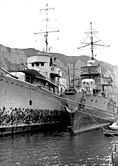|
Wikipedia
6,906,681 articles in English
|
|
Ljubljana was the third and last Beograd-class destroyer built for the Royal Yugoslav Navy in the late 1930s. She was designed to operate as part of a division led by Dubrovnik, the flotilla leader. Ljubljana entered service in November 1939, was armed with a main battery of four Škoda 120 mm (4.7 in) guns in single mounts, and had a top speed of 35 knots (65 km/h; 40 mph). In 1940, Ljubljana ran aground on a reef off the Yugoslav port of Šibenik, where, badly damaged, she was taken for repairs. Yugoslavia entered World War II when the Axis powers led by Germany invaded in April 1941, and Ljubljana—still under repair—was captured by the Royal Italian Navy. After repairs were completed, she saw active service in the Royal Italian Navy under the name Lubiana, mainly as a convoy escort on routes between Italy and North Africa. She was lost on 1 April 1943, when she ran aground and was abandoned off the Tunisian coast. (This article is part of a featured topic: Ships of the Royal Yugoslav Navy.) Cecilia Payne-Gaposchkin (1900–1979) was a British-born American astronomer and astrophysicist who proposed in her 1925 doctoral thesis that stars were composed primarily of hydrogen and helium. Her groundbreaking conclusion was initially rejected because it contradicted the scientific wisdom of the time, which held that there were no significant elemental differences between the Sun and Earth. Independent observations eventually proved she was correct. Her work on the nature of variable stars was foundational to modern astrophysics. Photograph credit: Science Service; restored by Adam Cuerden Recently featured: Tentacled flathead – The Abduction of Europa – Coconut
|
November 6: Gustavus Adolphus Day in Estonia, Finland and Sweden
More anniversaries:
|
About Wikipedia
- Help — A general help directory about anything and everything Wikipedia
- Navigation — An explanation of wikilinks and other methods of navigating the site
- Search — A help page about how to effectively search for articles
- Editing — An explanation of how to edit articles
- Current projects — On-going projects on which editors are currently focusing
- Reference desk — Ask volunteers encyclopaedic questions about many different subjects
- Mobile access — An explanation of how to access Wikipedia from a mobile device
- Contact us — Information about how to contact Wikipedia
Wikimedia Foundation
Wikipedia is made possible by the Wikimedia Foundation, a non-profit organization that hosts a range of projects coordinated by volunteers at Meta-Wiki. The largest projects are shown below:
| Wikipedia Encyclopedia | Wiktionary Dictionary & thesaurus | Wikibooks Textbooks & manuals | |||
| Wikiquote Quotations | Commons Free media | Wikinews News | |||
| Wikiversity Learning tools | Wikisource Source texts | Wikispecies Species directory |
Each project is available in multiple languages. This is the English Wikipedia, which is one of more than 250 Wikipedias currently available. Interlanguage links, appearing in the left column by default, are used to connect a page on the English Wikipedia to other Wikipedias' pages on the same subject. If an article exists in another Wikipedia but not here in English, you can visit the Translation Department for information about requesting translations or translating articles yourself.






